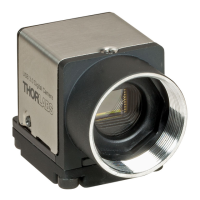© 2016 Thorlabs Scientific Imaging
4 Programming (SDK)
93
4.2.3 Capturing Images
DCx Cameras support the capture of single frames (snap) and frame sequences (live) in trigger
mode and untriggered (freerun) mode. Select the image capture mode that best meets your
application requirements.
Using events or messages, the uc480 driver can provide information to an application, e.g. about
the completion of image capture. You will need events and messages, for example, when you are
using image memory sequences.
4.2.3.1 Image Capture Modes
For more information on the capture modes of the DCx Cameras see also Camera basics:
Freerun and Camera basics: Trigger.
Freerun mode
In freerun mode, the camera sensor captures one image after another at the set frame rate.
Exposure of the current image and readout/transfer of the previous image data are performed
simultaneously. This allows the maximum camera frame rate to be achieved. The frame rate and
the exposure time can be set separately. The captured images can be transferred one by one or
continuously to the PC.
If trigger mode is active, you need to disable it with is_SetExternalTrigger() before activating
freerun mode.
Single frame mode (snap mode)
When is_FreezeVideo() is called, the next image exposed by the sensor is transferred. You
cannot use the DCxCamera flash outputs in this mode.
Continuous mode (live mode)
When is_CaptureVideo() is called, images are captured and transferred continuously. You can
use the DCxCamera flash outputs.
Trigger mode
In trigger mode, the sensor is on standby and starts exposing on receipt of a trigger signal. A
trigger event can be initiated by a software command (software trigger) or by an electrical signal
via the camera’s digital input (hardware trigger). For the specifications of the electrical trigger
signals, see the Specifications: Electrical specifications chapter.
The trigger mode is selected using is_SetExternalTrigger().
Software trigger mode
When this mode is enabled, calling is_FreezeVideo() immediately triggers the capture of an
image and then transfers the image to the PC. If is_CaptureVideo() is called, the triggering of
image capture and the transfer of images are performed continuously.
Hardware trigger mode
When this mode is enabled, calling is_FreezeVideo() makes the camera ready for triggering just
once. When the camera receives an electrical trigger signal, one image is captured and
transferred.
If you call is_CaptureVideo(), the camera is made ready for triggering continuously. An image is
captured and transferred each time an electrical trigger signal is received; the camera is then
ready for triggering again (recommended procedure).
Freerun synchronization
In this mode, cameras running in freerun mode (live mode, see above) can be synchronized with
an external trigger signal. The cameras still remain in freerun mode. The trigger signal stops and
restarts the current image capture process. You can use this mode to synchronize multiple

